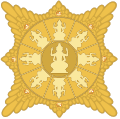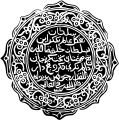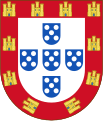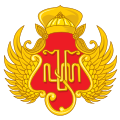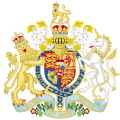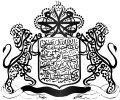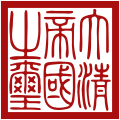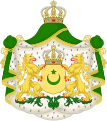National emblem of Indonesia
| National emblem of Indonesia Garuda Pancasila | ||
|---|---|---|
Shield An escutcheon representing the national ideology Pancasila ("The Five Principles"): | Quarterly Gules and Argent (national colours), parted per fess by a thick line Sable (symbolising the Equator); in the 1st quarter a banteng (Javanese wild bull) cabossed proper (for the 4th Principle), in the 2nd quarter a banyan tree proper (for the 3rd Principle), in the 3rd quarter a sprig each of paddy and cotton both proper (for the 5th Principle), in the 4th quarter a ring of annulets and mascles chain Or (for the 2nd Principle); on an inescutcheon, Sable a mullet Or (for the 1st Principle). | |
| Supporters | Garuda (a Javan hawk-eagle) displayed Or, clutching a scroll Argent of national motto | |
| Motto | Bhinneka Tunggal Ika (from Old Javanese: "unity in diversity") | |
| Other elements | The feathers of the Garuda are arranged to represent the date 17 August 1945, the day on which Indonesia's independence was proclaimed. | |
The national emblem
History
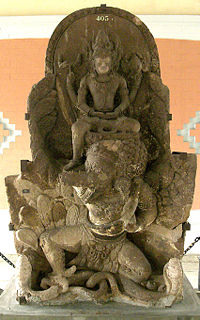
Garuda appear in many traditions and stories, especially in
After the
According to

Sultan Hamid II edited his design and proposed the new version, this time discarding the anthropomorphic form, the eagle-like Garuda was done in stylised naturalistic style and named Rajawali (eagle) Garuda Pancasila. President Sukarno presented this design to the cabinet and Prime Minister Hatta. According to AG Pringgodigdo in his book "Sekitar Pancasila" published by the Minister of Defence and Security, the improved design of Garuda Pancasila by Sultan Hamid II was officially adopted in United States of Indonesia Cabinet Assembly on 11 February 1950.[4] At that time, the Rajawali Garuda Pancasila was still "bald" without crest crowning its head like current version. President Sukarno introduced the national emblem of Indonesia to the public at Hotel Des Indes, Jakarta, on 15 February 1950.
Sukarno continued to improve the design of Garuda Pancasila. On 20 March 1950, Sukarno ordered the palace artist Dullah to make several improvements according to his suggestions, such as the addition of a crest and the change of talons position to the scroll. It was believed that Sukarno suggested the crest addition because the "bald" Garuda was considered too similar to the bald eagle in the United States Great Seal.[3]
Scroll and motto
The Garuda clutches in its talons a scroll bearing the National Motto of Indonesia, " who is said to have committed the phrase to writing for the first time.
The poem expounded a doctrine of reconciliation between the Hindu and Buddhist faiths: meaning literally "Although diverse, both truthful to Dharma — thus there exists no duality in Truth".[7][8] This spirit of religious tolerance was an essential element in the foundation and security of the newly emerging State of Majapahit and the thus fledgling Republic of Indonesia. It is roughly rendered, Diverse, yet united[9] or perhaps more poetically in English: Unity in Diversity.[10] The official Indonesian language translation is: Berbeda-beda namun tetap satu jua.
Uses

The National Emblem is used to symbolize Indonesian government and as official emblem of Indonesian ministries, departments and institutions. It is commonly displayed in Indonesian state palaces, monuments, government offices, buildings and also Indonesian embassies abroad. It is also used in private offices and buildings, also in the classes of public schools, placed on the wall slightly upper than the President's and Vice-President's photographs that flanked the emblem. Also, it is used on the front of every Naval vessel, denoting governmental status of the vessel. Moreover, every governor and head of cities or regencies wears the National Emblem on their headgear's badge. The President uses it on every plane he/she travelled with. Every Ministry, Provincial, Military and Police flag also uses it on one side.
The Indonesian National Emblem is used as part of governmental institutions' and organisations' emblems. Such as being included within the emblems of
In
However, some elements of Garuda Pancasila is used in some on non-national and non-governmental organisation. For example, the
Symbolism
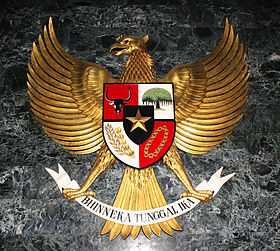
Garuda
The Garuda is the golden eagle, common to both Hinduism and Buddhism. The Garuda has the wings, beak, and feet of the golden eagle, but a man's arms and trunk. The Garuda is commonly used as an emblem in South and Southeast Asian nations. The use of the Garuda in Indonesia's coat-of-arms invokes the pre-colonial Hindu kingdoms that spanned across the archipelago, from which the present-day Republic of Indonesia is understood to be descended.
However, unlike the traditional
As for the national emblem, the Garuda symbolizes strength and power, while the gold color symbolizes greatness and glory.[2]
The feathers on the Garuda of the Indonesian coat-of-arms are arranged so that they invoke the date of 17 August 1945, the officially recognized Indonesian Day of Independence. The total number of feathers symbolizes the date of the
- The number of feathers on each wing totals 17
- The number of feathers on the tail totals 8
- The number of feathers below the shield or base of tail totals 19
- The number of feathers on the neck totals 45
These numbers of feathers correspond to "17/8/1945" international date format for Indonesian Independence Day.
Emblems
Each section of the shield has a symbol corresponding to the Pancasila principles laid down by its founder, President Sukarno. The numbers of some elements in these symbols might evokes certain numbers, such as 17 and 5 which represents the date of independence and the number of principles in Pancasila, respectively.

Escutcheon
The escutcheon (in heraldic terms) or shield is a martial symbol, representing the defense of the country. It is divided into five sections: a background divided into quarters, colored red and white (the colors of the national flag) in a checkerboard pattern; and a smaller, concentric shield, black in background. A thick, black line lies horizontally across the shield, symbolizing the equator which passes through the Indonesian archipelago.[2]

Star
The black shield bearing the golden star at center corresponds to the first Pancasila principle: "Belief in One Supreme God".
This tenet of Pancasila has been criticized, for it suggests compulsory religious belief as well as compulsory monotheism. Supporters of Sukarno's legacy, however, believe that this tenet was meant to unify Indonesia's population who have diverse beliefs and faiths from every part of the country (the star being a prominent symbol used by these faiths).

Chain
In the bottom right quarter, on a red background, is a chain made up of 9 round links representing women and 8 square links representing men, together they sum the number 17. This chain represents successive human generations. It corresponds to the second principle of the Pancasila, the principle of "Just and Civilized Humanity".[2] The chain is in gold color, representing the country's mineral wealth and its shape as a necklace is an indirect reference to its maritime wealth as it is a reminder of pearl necklaces made from sea pearls abundant in its waters.

Banyan tree
At the upper right quarter, on a white background, is the banyan tree (Indonesian: beringin). This symbol corresponds to the third Pancasila principle, the principle of "The Unity of Indonesia".[2] The banyan is known for having expansive above-ground roots and branches. The Republic of Indonesia, as an ideal conceived by Sukarno and the Nationalists, is one country out of many far-flung cultural roots, made up of millions of people from a number of ethnic communities and groups and from 38 provinces from far west of Sumatra to far east of Papua. The tree, common in many parts of the country, was for many years till the present the party symbol of Suharto's Golkar and thus one of the more recognizable symbols of the New Order period. It also thus represents Indonesia's indigenous flora and forests.

Bull
In the upper left quarter, on a red background, is the head of the Javanese wild bull, the

Rice and cotton
In the lower left quarter, on a white background, are a gold-and-white paddy and cotton. There are 17 seeds of rice and 5 cotton buds. These represent the fifth Pancasila principle, the principle of "Social Justice for the Entire People of Indonesia".[2] The rice and cotton represent sustenance and livelihood.
Garuda Pancasila song
The Garuda Pancasila song was composed by Sudharnoto as a patriotic song to commemorate the Indonesian struggle.[2]
- Lyrics
Garuda Pancasila
Akulah pendukungmu
Patriot proklamasi
Sedia berkorban untukmu
- Pancasila dasar negara
- Rakyat adil makmur sentosa
- Pribadi bangsaku
- Ayo maju maju
- Ayo maju maju
- Ayo maju maju
- Literal translation
O, Garuda Pancasila
I am your supporter
A patriot of Proclamation
(I am) willing to sacrifice for you
- Pancasila the basis of the country
- The people right and prospering
- My nation's character
- Let us go forth
- Let us go forth
- Let us go forth
- Poetic translation
O, Garuda Pancasila
A soldier for you, I am
A vanguard of Proclamation, I stand
I place my life and fortune in your hands
- Pancasila the law of the land
- People prospering hand-in-hand
- Our nation's pride and joy
- Onwards, march all
- Onwards, march all
- Onwards, march all
Gallery
-
The Surya Majapahit (1293–1527)
-
Seal of the Pagaruyung Kingdom (1347–1833)
-
Coat of arms of the Jambi Sultanate (1400–1904)
-
Coat of arms of the Aceh Sultanate (1496–1903)
-
Coat of arms of the Kingdom of Portugal (1512–1557)
-
Coat of arms of the Kingdom of Portugal (1557–1578)
-
Coat of arms of the Kingdom of Portugal (1578–1580)
-
Coat of arms of the Kingdom of Portugal (1580–1640)
-
Emblem ofits rule in Indonesia(1602–1799)
-
Coat of arms of the Dutch Republic (1610–1665)
-
Coat of arms of the Sultanate of Deli (1632–1946)
-
Coat of arms of the Kingdom of Portugal (1640–1815)
-
Coat of arms of the Dutch Republic (1665–1795)
-
Coat of arms of the Sultanate of Siak Sri Indrapura (1722–1949)
-
Coat of arms of the Surakarta Sunanate (1745–1945)
-
Coat of arms of the Yogyakarta Sultanate (1755–1950)
-
Coat of arms of Mangkunegaran (1757–1946)
-
Seal of the Lanfang Republic (1777–1884)
-
Seal of the Batavian Republic (1796–1802)
-
Coat of arms of the Dutch East Indies (1800–1949)
-
Seal of the Batavian Commonwealth (1802–1806)
-
Coat of arms of the Kingdom of Holland (1806–1810)
-
Coat of arms of the First French Empire (1810–1811)
-
Coat of arms ofCompany Raj(1811–1815)
-
Coat of arms of the United Kingdom (1811–1816)
-
Coat of arms of Pakualaman (1812–1950)
-
Coat of arms of the Sovereign Principality of the United Netherlands (1813–1815)
-
Coat of arms of the United Kingdom of Portugal, Brazil and the Algarves (1815–1825)
-
Coat of arms of the Kingdom of the Netherlands (1815–1907)
-
Coat of arms of the Riau-Lingga Sultanate (1824–1911)
-
Coat of arms of the Kingdom of Portugal (1825–1834)
-
Coat of arms of the Kingdom of Portugal (1834–1850)
-
Coat of arms of the Ottoman Empire (1846–1882)
-
Seal of the Qing dynasty (1862–1884)
-
Coat of arms of the Ottoman Empire (1882–1903)
-
Coat of arms of the Kingdom of the Netherlands (1907–1949)
-
Seal of the Empire of Japan (1942–1945)
-
Coat of arms of the Pontianak Sultanate (1945–1950)
-
Coat of arms of Indonesia (1950–present)
-
Coat of arms of Dutch New Guinea (1961–1962)
See also
- Coats of arms of Asia
- Emblems of Indonesia
- Emblem of Thailand
- Garuda
- Garuda Indonesia
- Pancasila
Notes
- ^ "National Symbols". Embassy of the Republic of Indonesia, Washington D.C. Archived from the original on 15 January 2020. Retrieved 18 July 2020.
- ^ a b c d e f g h i j "State Emblem". Indonesia.go.id. Archived from the original on 9 April 2012. Retrieved 23 March 2012.
- ^ a b Lambang Garuda Pancasila Dirancang Seorang Sultan Archived 9 August 2011 at the Wayback Machine
- ^ Kepustakaan Presiden Republik Indonesia, Hamid II Archived 21 July 2011 at the Wayback Machine
- ISBN 979-3525-08-8. 200 pages. pp. 155-157.
- ISBN 978-90-5789-152-6. 296 pages. pp. 186-203
- ^ Bhinneka Tunggal Ika:
Rwâneka dhâtu winuwus Buddha Wiswa, Bhinnêki rakwa ring apan kena parwanosen, Mangka ng Jinatwa kalawan Siwatatwa tunggal, Bhinnêka tunggal ika tan hana dharma mangrwa.
- ^ Santoso, Soewito Sutasoma. 1975. A Study in Old Javanese Wajrayana. New Delhi: International Academy of Culture. 1975. Page 578.
- ISBN 978-602-8397-41-4. Equinox 2009. 276 pages. xcviii, footnote 65.
- ^ "Departemen Hukum dan Hak Asasi Manusia Republik Indonesia - UUD 1945 - UUD 1945". Archived from the original on 12 February 2010. Retrieved 9 June 2011.
- ^ Rendy Sadikin (8 July 2014). "'Garuda Luka' Serang Prabowo-Hatta Lewat Dunia Maya". Tribunnews.com (in Indonesian). Archived from the original on 13 July 2014. Retrieved 14 October 2014.
- ^ Ina Parlina; Margareth S. Aritonang (26 June 2014). "Nazi-inspired rocker hurts Prabowo's bid". The Jakarta Post. Archived from the original on 18 October 2014. Retrieved 14 October 2014.
- ^ Marlinda Oktavia Erwanti (10 October 2018). "Seperti 2014, Prabowo Kembali Pakai Garuda Merah di Pilpres 2019". Detik.com (in Indonesian).
- ^ Keputusan Presiden No. 4/1993, issued on 10 January 1993, the status of Elang Jawa (Javan hawk-eagle) as the national bird of Indonesia (Widyastuti 1993, Sözer et al. 1998).
- ^ Department of Information, Republic of Indonesia (1999), pp46-47
References
- Department of Information, Republic of Indonesia (1999) Indonesia 1999: An Official Handbook (No ISBN).

